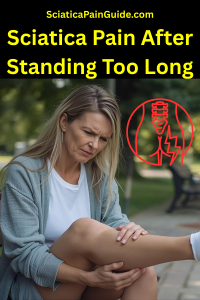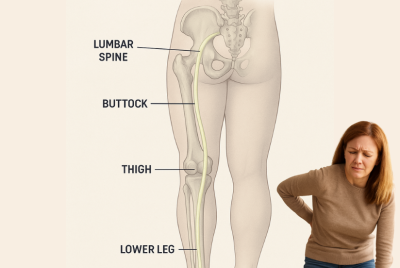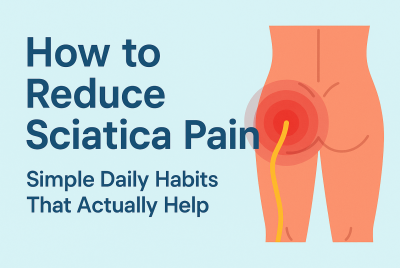Sciatica Pain After Standing Too Long: Causes, Relief, and Prevention
Why Standing Can Trigger Sciatica Pain
If you’ve ever felt sharp pain, numbness, or tingling shooting down your leg after standing too long, you’re not alone. Many people with sciatica struggle with discomfort that worsens when they remain upright. The pain can make simple tasks—like waiting in line, cooking, or attending events—feel unbearable. Sciatica pain after standing too long is a common flare-up symptom linked to pressure on the sciatic nerve, which runs from your lower back through your hips and legs. This article will explain why standing triggers the pain, what you can do to find relief, and how to prevent it from happening in the first place.
What Causes Sciatica Pain After Standing Too Long?
Several factors contribute to sciatica pain when standing:
-
Herniated Disc Sciatica: When a spinal disc presses on the sciatic nerve, prolonged standing increases the compression.
-
Spinal Stenosis: Narrowing of the spinal canal can worsen symptoms in upright positions.
-
Piriformis Syndrome Sciatica: A tight piriformis muscle in the buttocks can irritate the sciatic nerve.
-
Poor Posture: Standing with misaligned hips or a curved lower back places strain on the sciatic nerve.
-
Wallet Sciatica (Piriformis Compression): Sitting or standing with a wallet in your back pocket can irritate the nerve over time, leading to flare-ups.
Symptoms That May Worsen When Standing
When sciatica is aggravated by standing too long, you might notice:
-
Sharp lower back pain radiating into the buttock or leg
-
Tingling or numbness in the thigh, calf, or foot
-
Leg weakness after prolonged standing
-
Burning pain down the sciatic nerve pathway
-
Increased difficulty walking or shifting weight
If your symptoms persist or worsen, it may indicate chronic sciatica requiring medical evaluation.
Why Standing Triggers Sciatic Nerve Pain
Standing for extended periods can strain your spine and leg muscles. Here’s why:
-
Increased Load on the Lower Back: Standing adds pressure to the lumbar spine, especially if posture is poor.
-
Muscle Fatigue: Tired core and leg muscles reduce spinal support, increasing nerve compression.
-
Reduced Circulation: Blood flow to the lower extremities decreases, contributing to numbness or tingling.
-
Nerve Compression Worsens Over Time: Prolonged pressure on the sciatic nerve intensifies pain signals.
Best Treatments for Sciatica Pain After Standing Too Long
1. At-Home Relief Strategies
-
Heat or Ice for Sciatica: Apply ice for the first 24–48 hours of a flare-up, then switch to heat for muscle relaxation.
-
Over-the-Counter Medications: NSAIDs like ibuprofen reduce inflammation and ease pain.
-
Wallet Sciatica Relief at Home: Remove bulky wallets from your back pocket to avoid piriformis compression.
-
Change Positions Frequently: Alternate between sitting, standing, and gentle walking.
2. Natural Remedies for Sciatica
-
Gentle Sciatica Stretches at Home: Stretching the hamstrings, hip flexors, and piriformis can ease pressure.
-
Yoga and Pilates: Help improve flexibility and core strength, reducing sciatic nerve compression.
-
Anti-Inflammatory Diet: Foods like salmon, leafy greens, and berries may help reduce chronic inflammation.
3. Medical Treatment Options
-
Physical Therapy for Sciatica: Strengthens core and lower back muscles while improving posture.
-
Epidural Steroid Injections: Provide short-term relief for severe inflammation.
-
Surgery (Last Resort): Recommended only for severe, chronic sciatica from herniated discs or stenosis.
Sciatica Exercises for Pain Relief
Try these safe movements when you experience sciatica pain after standing too long:
-
Piriformis Stretch: Lie on your back, cross one ankle over the opposite knee, and gently pull the lower leg toward your chest.
-
Knee-to-Chest Stretch: Reduces lower back tension and sciatic nerve irritation.
-
Seated Hamstring Stretch: Sit on a chair and extend one leg forward with toes up; lean gently forward.
-
Pelvic Tilts: Strengthen core stability and improve lumbar alignment.
Always perform exercises slowly and stop if pain worsens.
Lifestyle Tips to Prevent Sciatica Flare-Ups
Preventing sciatica pain isn’t just about treating symptoms when they appear—it’s about building habits that keep your back and nerves healthy long term. Here are practical, everyday strategies:
1. Prioritize Good Posture
-
Keep your shoulders back and core engaged when standing.
-
Avoid slouching while sitting or leaning on one hip when standing.
-
Use ergonomic chairs or lumbar cushions to maintain spinal alignment.
2. Break Up Long Periods of Standing or Sitting
-
Set a reminder to move every 20–30 minutes.
-
Alternate between standing, sitting, and short walks.
-
At work, consider a sit-stand desk to balance posture.
3. Exercise Regularly for Back Health
-
Low-impact activities like swimming, walking, or stationary cycling support the spine.
-
Strengthen core muscles with Pilates or yoga to reduce nerve compression.
-
Incorporate sciatica stretches at home—especially hamstring and piriformis stretches.
4. Choose Supportive Footwear
-
Wear shoes with cushioning and arch support.
-
Avoid high heels, flip-flops, or unsupportive flats.
-
Orthotic inserts can help if you have flat feet or imbalances.
5. Maintain a Healthy Weight
Excess weight puts additional pressure on the lower back and sciatic nerve. Even modest weight loss can reduce flare-ups. Focus on a balanced diet with anti-inflammatory foods such as:
-
Salmon, walnuts, and flaxseed (omega-3s)
-
Dark leafy greens and colorful vegetables
-
Berries and citrus fruits
6. Lift Objects Safely
-
Always bend at the knees, not the waist.
-
Keep heavy items close to your body when lifting.
-
Avoid twisting your back while carrying weight.
7. Improve Your Sleep Setup
-
Use a medium-firm mattress that supports your spine.
-
Experiment with the best sleeping positions for sciatica (side with a pillow between knees, or back with a pillow under knees).
-
Avoid stomach sleeping to reduce lower back strain.
8. Manage Stress and Muscle Tension
Stress can lead to muscle tightness, especially in the lower back and hips. Try:
-
Deep breathing exercises
-
Mindfulness or meditation
-
Warm baths with Epsom salts to relax muscles
9. Stay Hydrated
Drinking enough water keeps spinal discs cushioned and flexible, lowering the risk of compression that can trigger sciatica flare-ups.
👉 By making these adjustments, you’ll reduce your risk of sciatica pain after standing too long and build resilience against future flare-ups.
Best Sleeping Position for Sciatica Relief
Many people with sciatica find their pain worsens at night. Here’s how to improve sleep:
-
Side Sleeping with a Pillow: Place a pillow between your knees to align the spine.
-
Back Sleeping with Knee Support: Put a pillow under your knees to reduce lower back strain.
-
Avoid Stomach Sleeping: This can increase lumbar arching and nerve compression.
Real-Life Coping Strategies
People in the U.S. living with chronic sciatica often combine multiple approaches:
-
Using standing desks with anti-fatigue mats at work
-
Practicing daily sciatica stretches at home
-
Trying physical therapy and chiropractic care
-
Applying heat or ice for sciatica relief after long days
-
Exploring natural remedies for sciatica, like turmeric, omega-3s, and Epsom salt baths
✅ Sciatica Lifestyle Cheat Sheet: Prevent Flare-Ups
Posture & Movement
-
Stand tall with your shoulders back and your core engaged
-
Sit with lumbar support or use a cushion
-
Change position every 20–30 minutes
-
Use a sit-stand desk if possible
Exercise & Flexibility
-
Do daily low-impact exercise (walking, swimming, cycling)
-
Strengthen your core with yoga or Pilates
-
Stretch hamstrings and piriformis regularly
-
Include sciatica stretches at home in your routine
Footwear & Daily Habits
-
Wear shoes with arch support and cushioning
-
Avoid high heels and unsupportive flats
-
Use orthotic inserts if needed
-
Lift objects by bending your knees, not your waist
Lifestyle & Health
-
Maintain a healthy weight to ease back pressure
-
Eat anti-inflammatory foods (salmon, greens, berries)
-
Stay hydrated to keep spinal discs cushioned
-
Practice stress relief: meditation, breathing, warm baths
Sleep & Recovery
-
Sleep on a medium-firm mattress
-
Use a pillow between or under your knees
-
Avoid stomach sleeping
👉 Print this checklist or save it on your phone for quick reminders. Small, consistent changes go a long way in keeping sciatica pain after standing too long under control.
FAQs About Sciatica Pain After Standing Too Long
1. Why does sciatica pain get worse after standing?
Standing adds spinal pressure, compresses the sciatic nerve, and reduces circulation in the legs, which worsens pain over time. Poor posture or weak muscles make the problem more severe.
2. How long should I stand with sciatica before taking a break?
Experts recommend shifting positions every 20–30 minutes. Alternating between sitting, walking, and stretching prevents nerve compression and reduces sciatica flare-ups.
3. Can shoes affect sciatica pain after standing too long?
Yes. Unsupportive footwear, especially high heels or flat shoes without arch support, increases spinal strain. Supportive shoes with cushioning can help reduce sciatic nerve irritation.
4. What are the best home remedies for sciatica after standing?
Heat or ice therapy, gentle stretches, NSAIDs, and wallet sciatica home remedies like removing bulky items from your pocket all provide relief. Lifestyle changes are also key.
5. Does walking with sciatica pain help or hurt?
Gentle walking can improve circulation and reduce stiffness, but long walks may worsen pain. Short, frequent walks are best for managing symptoms.
6. Should I see a doctor if sciatica pain only happens when standing?
Yes, especially if symptoms persist or include numbness, weakness, or bladder/bowel issues. These may indicate chronic or acute sciatica requiring medical attention.
7. Can physical therapy cure sciatica pain from standing too long?
While not always a cure, physical therapy strengthens muscles, improves posture, and relieves sciatic nerve pressure. Many patients see long-term improvement with consistent therapy.
Conclusion: Take Control of Your Sciatica Pain
Living with sciatica pain after standing too long doesn’t mean giving up your normal activities. By combining stretches, posture adjustments, natural remedies, and medical treatments when necessary, you can reduce pain and prevent flare-ups. Small lifestyle changes—like supportive footwear, standing breaks, and daily sciatica exercises—make a big difference in long-term relief.
Disclaimer
This article is for informational purposes only and does not replace professional medical advice. Always consult a qualified healthcare provider before starting new treatments, exercises, or medications for sciatica or back pain.
 Next Reads:
Next Reads:



 Next Reads:
Next Reads:

